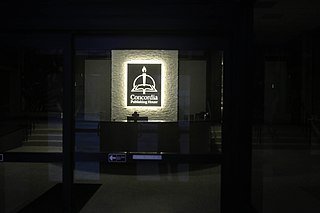
The Lutheran Church – Missouri Synod (LCMS), also known as the Missouri Synod, is a traditional, confessional Lutheran denomination in the United States. With 1.8 million members as of 2021, it is the second-largest Lutheran body in the United States, behind the Evangelical Lutheran Church in America. The LCMS was organized in 1847 at a meeting in Chicago, Illinois, as the German Evangelical Lutheran Synod of Missouri, Ohio, and Other States, a name which partially reflected the geographic locations of the founding congregations.

Concordia Theological Seminary is a Lutheran seminary in Fort Wayne, Indiana. It offers professional, master's degrees, and doctoral degrees affiliated with training clergy and deaconesses for the Lutheran Church–Missouri Synod (LCMS).

Concordia Seminary is a Lutheran seminary in Clayton, Missouri. The institution's primary mission is to train pastors, deaconesses, missionaries, chaplains, and church leaders for the Lutheran Church–Missouri Synod (LCMS). Founded in 1839, the seminary initially resided in Perry County, Missouri. In 1849, it was moved to St. Louis, and in 1926, the current campus was built.

Seminex is the widely used abbreviation for Concordia Seminary in Exile, which existed from 1974 to 1987 after a schism in the Lutheran Church–Missouri Synod (LCMS). The seminary in exile was formed due to the ongoing Fundamentalist–Modernist Controversy that was dividing Protestant churches in the United States. At issue were foundational disagreements on the authority of Scripture and the role of Christianity. During the 1960s, many clergy and members of the LCMS grew concerned about the direction of education at their flagship seminary, Concordia Seminary, in St. Louis, Missouri. Professors at Concordia Seminary had, in the 1950s and 1960s, begun to utilize the historical-critical method to analyze the Bible rather than the traditional historical-grammatical method that considered scripture to be the inerrant Word of God.

Concordia Senior College was a liberal arts college located in Fort Wayne, Indiana, and affiliated with the Lutheran Church–Missouri Synod (LCMS). It was founded in 1957 and closed in 1977.

The Evangelical Lutheran Synodical Conference of North America, often known simply as the Synodical Conference, was an association of Lutheran synods that professed a complete adherence to the Lutheran Confessions and doctrinal unity with each other. Founded in 1872, its membership fluctuated as various synods joined and left it. Due to doctrinal disagreements with the Lutheran Church–Missouri Synod (LCMS), the Evangelical Lutheran Synod (ELS) and the Wisconsin Evangelical Lutheran Synod (WELS) left the conference in 1963. It was dissolved in 1967 and the other remaining member, the Synod of Evangelical Lutheran Churches, merged into the LCMS in 1971.

The Concordia Lutheran Conference (CLC) is a small organization of Lutheran churches in the United States which formed in 1956. It was a reorganization of some of the churches of the Orthodox Lutheran Conference (OLC), which had been formed in September 1951, in Okabena, Minnesota, following a break with Lutheran Church–Missouri Synod (LCMS). It is the remaining successor of the Orthodox Lutheran Conference. The current president is David T. Mensing, pastor of Peace Evangelical Lutheran Church in Oak Forest, Illinois. All members of the board of directors serve one year terms. The CLC has five congregations and is in fellowship with nine mission congregations in Russia and Nigeria.

The Evangelical Lutheran Free Church is a confessional Lutheran denomination based in Germany and Austria. It currently consists of 1,300 members in 17 congregations. The ELFK maintains a seminary for the training of pastors in the city of Leipzig.

The Lutheran Churches of the Reformation (LCR) is an association of Lutheran congregations. The LCR has its roots among groups of Lutherans that broke with the Lutheran Church–Missouri Synod (LCMS) in the middle of the 20th century, and was formally incorporated in 1964. Church services are generally traditional and reverent in the style of the mid-1900s conservative Christians.

Concordia Publishing House (CPH), founded in 1869, is the official publishing arm of the Lutheran Church–Missouri Synod (LCMS). Headquartered in St Louis, Missouri, at 3558 S. Jefferson Avenue, CPH publishes the synod's official monthly magazine, The Lutheran Witness, and the synod's hymnals, including The Lutheran Hymnal (1941), Lutheran Worship (1982), and Lutheran Service Book (2006). It publishes a wide range of resources for churches, schools, and homes and is the publisher of the world's most widely circulated daily devotional resource, Portals of Prayer. Its children's books, known as Arch Books, have been published in millions of copies. Concordia Publishing House is the oldest publishing company west of the Mississippi River and the world's largest distinctly Lutheran publishing house.
Concordia College Alabama was a Private historically black college associated with the Lutheran Church–Missouri Synod and located in Selma, Alabama. It was the only historically black college among the ten colleges and universities in the Concordia University System. The college ceased operations at the completion of the spring 2018 semester, citing years of financial distress and declining enrollment.
Jacob Aall Ottesen Preus II was an American Lutheran pastor, professor, author, seminary president and church denominational president. He served as the eighth president of the Lutheran Church–Missouri Synod (LCMS) from 1969 to 1981. He was a major figure in the "Seminex" theological/political controversy, which resulted in a schism in the LCMS during the early 1970s.

Robert David Preus was an American Lutheran pastor, professor, author, and seminary president.
The India Evangelical Lutheran Church (IELC) is a confessional Lutheran Christian church body of India headquartered in Tamil Nadu. It belongs to the International Lutheran Council and the Lutheran World Federation. It has three synods, named Ambur Synod, Nagercoil Synod, and Trivandrum Synod. The IELC was founded through the missionary efforts of the US-based Lutheran Church–Missouri Synod (LCMS), with whom it remains in altar and pulpit fellowship.
Lutheranism was first introduced to Mexico in the 1850s, when German-American Lutherans began serving German immigrants in Mexico, though mission work among the non-German population in Mexico did not begin until the 1940s. Today there are five Lutheran church bodies in Mexico—the Mexican Lutheran Church, the Lutheran Synod of Mexico, the Confessional Evangelical Lutheran Church—Mexico, the Evangelical Lutheran Church of Mexico (unaffiliated), and the Lutheran Apostolic Alliance of Mexico (unaffiliated)—and several independent congregations.

Concordia College was a Lutheran college and high school in Conover, North Carolina. Founded as a high school by members of the Evangelical Lutheran Tennessee Synod in 1878, it added college courses in 1881. The English Evangelical Lutheran Synod of Missouri and Other States took over control of the school in 1893. Control passed to the Lutheran Church–Missouri Synod when the English Synod merged with it in 1911. In April 1935, a fire destroyed the main building, and the school closed permanently at the end of the spring semester.
Luther College was a private black school in New Orleans, Louisiana, United States. It was established by the Evangelical Lutheran Synodical Conference of North America in 1903 as part of the conference's missionary work among African Americans in the Southern United States following the American Civil War. The school was founded the same year as Immanuel Lutheran College in Concord, North Carolina, and both schools had the same three departments: a secondary school, a normal school, and a seminary.
Rosa Jinsey Young was an African American Lutheran educator who worked primarily in the Black Belt of Alabama. Born in Rosebud, Alabama, to Grant, an African Methodist Episcopal pastor, and Nancy Young, Rosa Young was the valedictorian of her 1909 graduating class at Daniel Payne College in Selma, Alabama. She founded her first school, Rosebud Literary and Industrial School, in 1912. Within two years, attendance at her school grew from 7 to 215.
The following is a timeline of significant events in the history of the Lutheran Church – Missouri Synod.









